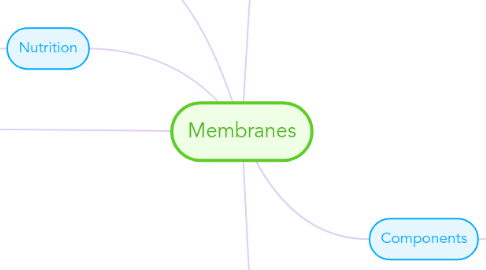
1. Permeability
1.1. Phospholipid Bilyers
1.2. Cellular Membranes
2. Transport
2.1. Passive Transport
2.1.1. Osmosis
2.1.2. Facilitated Diffusion Across Membrane
2.2. Active Transport
3. Nutrition
3.1. Phagocytosis
3.2. Endocytosis
4. Functions
4.1. Lipid
4.1.1. Phosphoglyerides
4.1.2. Shingolipids
4.1.3. Sterols
4.2. Protein
4.2.1. Peripheral
4.2.2. Integral
4.3. Carbohydrate
4.3.1. Mono, di-, oligosaccharide components of glycoproteins, glycolipids
5. Components
5.1. Selectively permeable membrane (lipid bilayer)
5.2. Compartmentalization of Function
5.3. Energy Transduction (change energy into another form)
5.3.1. Inner mitochondrial membrnae
5.3.2. Chloroplast thylakoids
5.3.3. Bacterial plasma membrane
5.4. Transport
5.4.1. solutes, water (aquaporins)
5.5. Sites of enzymatic activity
5.6. Communication
5.6.1. Signal transduction (hormone receptor in the pasma membrane)
5.6.2. Cell-cell recognition (glycoprotein identification tag)
5.6.3. Signal transduction (hormone receptor in the pasma membrane)
5.7. Intercellular joining (gap junctions, tight junctions)
5.8. Anchorage: to cytoskeleton and ECM (extracellular matrix)
5.9. 6
5.9.1. Signal transduction is when the binding of the messenger to the receptor triggers a chain reaction involving other proteins, which relay the message to a molecule that performs a specific activity inside the cell.
5.9.2. Cell-cell recognition is the ability of a cell to distinguish one type of neighboring cell from another. This attribute is important in cell sorting and organization as tissues and organs in development. It is also the basis for rejection of foreign cells by the immune system. Cells recognize other cells by keying on surface molecules, often carbohydrates, on the plasma membrane.
5.9.3. Intercellular joining is when membrane proteins of adjacent cells may be hooked together in various kinds of intercellular junctions. Some membrane proteins (CAMs) of this group provide temporary binding sites that guide cell migration and other cell-to-cell interactions.
5.9.4. Enzymatic activity is when a protein built into the membrane may be an enzyme with its active site exposed to substances in the adjacent solution. In some cases, several enzymes in a membrane act as a team that catalyzes sequential steps of a metabolic pathway as indicated (left to right) here.
5.9.5. Attachment to the cytoskeleton and extracellular matrix (ECM): Elements of the cytoskeleton (cell’s internal supports) and the extracellular matrix (fibers and other substances outside the cell) may be anchored to membrane proteins, which help maintain cell shape and fix the location of certain membrane proteins. Others play a role in cell movement or bind adjacent cells together.

